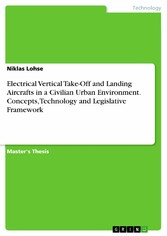Suchen und Finden
Electrical Vertical Take-Off and Landing Aircrafts in a Civilian Urban Environment. Concepts, Technology and Legislative Framework
Mehr zum Inhalt

Electrical Vertical Take-Off and Landing Aircrafts in a Civilian Urban Environment. Concepts, Technology and Legislative Framework
Master's Thesis from the year 2019 in the subject Engineering - Aerospace Technology, grade: 1,5, University of Applied Sciences Wildau, language: English, abstract: This Paper will introduce the most developed concept of vertical take off and landing (VTOL) aircrafts and assess them. It will also analyse the key technology challenges and the legislative situation. The world's population is growing and people continue to move from rural to urban areas. This is accompanied by an increasing number of cars. As a result of this, traffic jams in densely populated areas and long commutes are becoming omnipresent. Extension possibilities for existing infrastructure, especially within urban areas, are very limited due to space. Consequently, innovative alternatives are required. Flying cars, also known as vertical take off and landing (VTOL) aircraft, still appear to be a future vision which seems to be far away. However, to date, more than 200 of such concepts around the world are being developed, some of which are even performing flight tests. The objective of this Master's Thesis therefore is to evaluate if flying cars have a realistic potential to improve the overloaded ground infrastructure systems on a mid-term ten years basis. In order to answer the research question, a conceptual examination and subsequent classification of the existing concepts is conducted. Based on this a profound content analysis of the four most mature aircraft is carried out. As a result, three significant technical challenges emerge: batteries, noise pollution and the autonomous flying capability. By performing another content analysis on these obstacles, their respective relevance and impact following an upcoming vehicle certification is investigated. Furthermore, VTOL aircraft operations would require legislative amendments. Hence, the current legal situations and actual activities in those regions are studied, where the four companies with the most mature concepts are based. On that basis it can be concluded, that flying cars have a huge potential to relieve the overstressed infrastructure systems on the ground. Although more than ten years will be required to significantly improve this situation, the first flying cars will most likely be visible much sooner. Technical as well as legal challenges exist, but are not insurmountable and especially the latter are relatively well developed already to enable VTOL operations in an urban environment in the near future.
Alle Preise verstehen sich inklusive der gesetzlichen MwSt.






